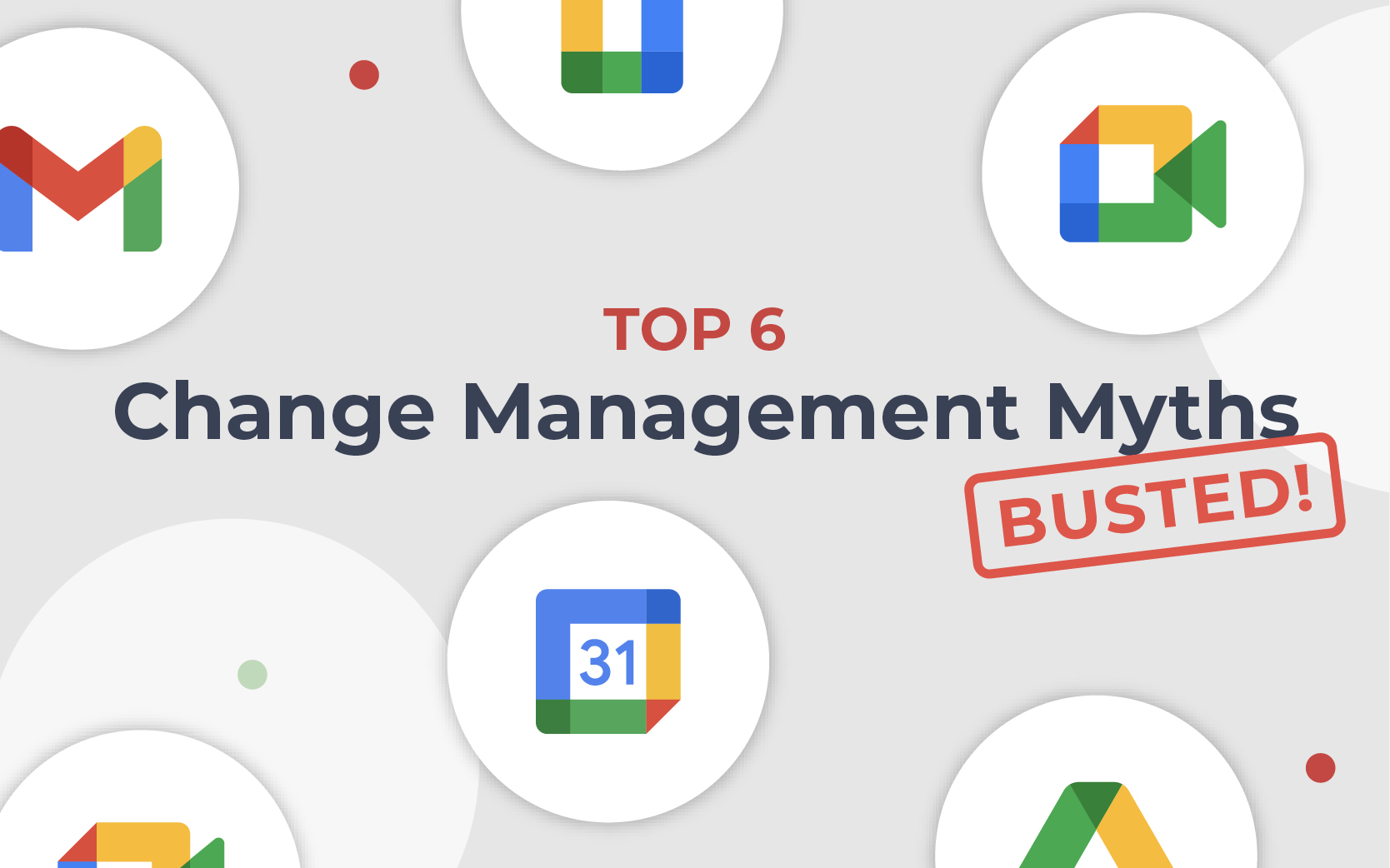Top 6 Change Management Myths Busted

Google Workspace is user friendly, which greatly eases the transition for users. However, it doesn’t entirely negate the need for change management (CM). In this blog post, we explore the top 6 common myths driving organizations to skip CM and what the outcomes are likely to be… versus what occurs with a well-structured approach to CM.
1. “Google Workspace tools are easy to use, intuitive, and already popular for personal use. Our team doesn’t need training or structured change management.”
While Google Workspace is indeed user-friendly, there are differences for users shifting from personal use to Google Workspace enterprise. For example, how to categorize emails automatically and select from the various permissions when sharing files.
Some learning curve is inevitable, but with Wursta we help shorten the time and allow your IT team to focus on implementation while we help support your team members. There will be differences between how your staff is currently operating and how their duties might change on Google Workspace. Typically, everyone is too busy with their day-to-day job to dedicate time to experimenting to figure out, for example, how filters work in Gmail.
CM should strive to understand those differences and determine how to close the gap to get them there. By reducing learning curves, CM puts your team on the fast track to becoming power users. Ideally, your transition might further benefit from tailoring CM to individual employees, groups, roles, or departments.
2. “Our IT team is already equipped to train users. We can handle the process internally to save money.”
We wouldn’t disagree that your IT team is capable of training users and answering their Qs. But questions inevitably pop up during the roll out of new technology. This new, added burden will increase overall workload, taking up bandwidth they’re unlikely to have.
In addition to supporting users, your team will have to create the how-to documentation. It’s ideal to develop training resources that speak to your organization’s unique implementation, rather than relying on standard Google Workspace documentation.
These increases in workload can inhibit your team’s ability to handle other support tickets and accomplish things that bring value to your business and enhance your competitive advantage. Skipping CM can be penny wise and pound foolish.
3. “Google Workspace offers user-friendly functionality that users are eager to embrace, so encouraging them to fully adopt the tools is unnecessary.”
New technology usually improves productivity and makes business processes more efficient. (At least… that’s the goal.) However, users still face a learning curve with any change. It can take time to adjust to new tools, which can result in productivity downtime.
Old habits are hard to break, and shadow IT crops up as users continue to leverage tools like Box. You’re already paying for Google Drive, so this results in entirely unnecessary IT expenditures. Worse, it leads to information security risks and possible compliance violations as secure data, such as Protected Health Info (PHI) could be shared externally.
4. “Our team already knows how to use Microsoft Excel, and Google Sheets is similar enough.”
Yes, there are similarities, but there are also some differences your team will have to adjust to. Without adequate training, problems could result. For example, senior management might learn that year-end financial statements are delayed because your finance team is struggling with Google Sheets. This wouldn’t reflect well on you, as the owner of the Google Workspace transition.
However, if you provide the resources to get them up and running, you will have performed your due diligence (even if they choose not to attend trainings.) While not every employee will be 100% comfortable with all functionalities, you need to make the effort to equip them for success.
5. “All the employees know that Google Workspace is great and are excited to use it. The only communicating we need to do is tell them when we’re switching.”
Google products are widely used and well-loved, making resistance to the transition generally quite limited. However, the fact remains that some learning curve is inevitable. Considering everyone is busy fulfilling their daily duties, it’s common to encounter some hesitation to make the investment needed to learn new tech. Sticking with what we know can simply be easier than taking any time –however brief– to learn a new way, even if that new way is quicker and easier.
Even if you’re not facing any hesitation, there could be some anxiety about the shift. It’s still important to communicate and make efforts to increase buy-in. When users understand the vision behind the migration, they’re more likely to tolerate the learning curve. Users should also feel as though they’re heard, rather than having the change forced on them from above, with any concerns dismissed and ignored.
6. “We know we’ve properly configured Google Workspace, so we’re ready to deploy.”
Migrating to Google Workspace is a shift to new technology, which will have a variety of impacts on your organization – potentially including some that were unforeseen. Discovering business impacts at the last minute risks extending your project timeline.
The only thing worse than bad news is bad news late. Business impacts must be uncovered prior to things breaking and resulting in disrupted operations, data loss, or even lost revenue.
The Value of Change Management

Wursta’s Organizational Change Management Services
Successful technology transformations require just as much, if not more, effort on the people side. A structured and dedicated focus on change management is vital to a successful transition.
Wursta’s organizational change management services support your roll out of new technology, decreasing time to value by avoiding substantial dips in efficiency and productivity. We take your users through what could be a frustrating stumble and swiftly make them power users.



